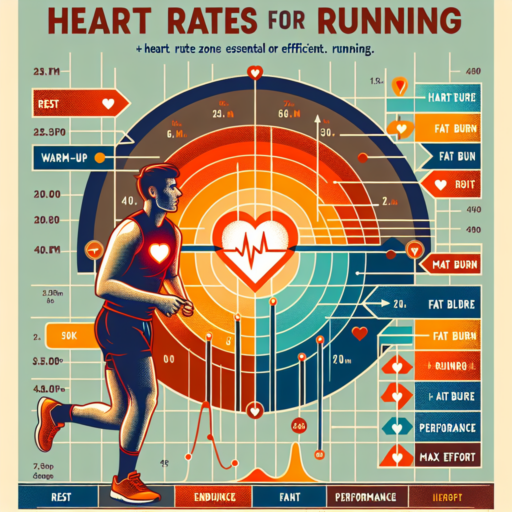No se han encontrado productos.
What is the heart rate zone for marathon training?
Understanding the heart rate zone for marathon training is crucial for optimizing your performance and ensuring you train effectively. Marathon training requires a strategic blend of intensity levels, and the heart rate zone is a fundamental aspect to consider. Most trainers and seasoned runners rely on the heart rate zone to tailor their training sessions for improved endurance and speed, minimizing the risk of overtraining.
Identifying Your Marathon Training Heart Rate Zone
To accurately determine your marathon training heart rate zone, you should first establish your maximum heart rate (MHR). The widely accepted formula to estimate your MHR is to subtract your age from 220. Once you have this figure, the marathon training typically falls between 60-80% of your MHR. This range is considered the aerobic zone, promoting cardiovascular efficiency and endurance. Training in this zone helps your body become more efficient at using fat as fuel, which is indispensable for the long distances covered during a marathon.
Benefits of Training in This Zone
Training within your marathon heart rate zone has multiple benefits. It improves your aerobic base, increases the size and number of your mitochondria, enhances your fat-burning capabilities, and reduces the risks of injury by preventing overtraining. Regularly training in your specific heart rate zone also allows your body to recover faster, ensuring you’re prepared for the next day’s training.
While the focus on heart rate zones might seem a bit technical, incorporating this approach into your marathon training can significantly enhance your efficiency and performance. It’s about training smarter, not harder, by understanding and utilizing the physiological indicators that signal your optimal training intensity.
What is a safe heart rate for marathon?
Discovering a safe heart rate for marathon running involves understanding both your personal fitness levels and general guidelines set by health professionals. A marathon is a demanding physical challenge that requires careful preparation and awareness of your body’s signals. While an ‘ideal’ heart rate can vary significantly between individuals, certain ranges are considered safer and more effective for endurance events like marathons.
To gauge a safe heart rate, many athletes refer to the concept of maximum heart rate (MHR), which is generally calculated as 220 minus your age. However, this is a rough estimate and can vary based on fitness levels, genetics, and factors such as temperature and hydration. When running a marathon, aiming to maintain a heart rate within 70-85% of this MHR is recommended for most of the race, ensuring you are working within an aerobic zone that promotes stamina and endurance.
Monitoring Your Heart Rate
Keeping an eye on your heart rate during training and the marathon itself is vital. Devices such as heart rate monitors or smartwatches can provide real-time data, helping to manage your pace and prevent overexertion. Listen to your body, and if your heart rate climbs too high for too long, it may be a sign to slow down, hydrate, and assess your physical condition. Notably, experienced marathon runners may be able to sustain slightly higher heart rates safely due to their advanced conditioning and familiarity with their body’s responses to prolonged exercise.
What is a good resting heart rate for a marathon runner?
Understanding the ideal resting heart rate for a marathon runner requires examining a blend of physiological health markers and athletic endurance. Essentially, a good resting heart rate (RHR) for marathon athletes falls within a specific range, thought to reflect both cardiovascular efficiency and running performance. This rate indicates the heart’s ability to pump blood throughout the body efficiently, a crucial factor for endurance sports.
Generally, the average RHR for adults ranges from 60 to 100 beats per minute (bpm). However, for marathon runners, this rate can be significantly lower, often observed between 40 and 60 bpm. This lower rate is attributable to the increased heart muscle efficiency developed through prolonged endurance training, resulting in a stronger heart that can pump a greater volume of blood per beat. Elite marathon runners may exhibit resting heart rates at the lower end of this spectrum, signifying their high level of cardiovascular fitness.
It’s important to note that individual variances in RHR are influenced by factors such as age, sex, and overall health. Consequently, marathon runners should aim for a resting heart rate that is not only within the optimal range for endurance athletes but also reflective of their personal health and fitness levels. Monitoring the RHR over time can offer valuable insights into a runner’s cardiovascular health, recovery status, and readiness for intense training sessions or competitions.
Is a 190 heart rate bad while running?
When assessing whether a 190 heart rate is bad while running, it’s essential to consider individual fitness levels, age, and the intensity of the exercise. Generally, heart rate is a personal metric and varies from one individual to another depending on various factors including physical condition and existing health concerns.
Understanding Your Maximum Heart Rate
The concept of maximum heart rate (MHR) is critical in determining if a 190 heart rate is alarming. MHR can be roughly estimated by subtracting your age from 220. For a younger person, a heart rate nearing 190 might be within their high-intensity exercise range. However, for older adults, reaching a 190 heart rate could signify pushing beyond their safe exercise intensity, possibly venturing into zones that could be harmful over time.
Exercise intensity levels are often categorized by heart rate zones. A heart rate of 190 beats per minute might fall into the anaerobic or high-intensity zone for many people. This level of intensity is generally maintained for shorter durations during interval training or vigorous activities. Consistently operating at this high of a rate can lead to overexertion and might not be sustainable or safe for extended periods, especially for those unaccustomed to high-intensity workouts.
Listening to Your Body: It’s vital to listen to your body’s signals when running or engaging in any form of exercise. Symptoms like dizziness, excessive shortness of breath, or chest pain at high heart rates demand immediate attention and could indicate that a 190 heart rate is indeed too high for your current fitness level or health status. Regular monitoring of your heart rate during exercise, understanding your personal limits, and gradually increasing the intensity of your workouts can help manage and interpret what heart rates are appropriate for your fitness goals and health.




